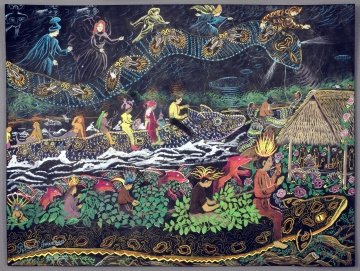
Richard F. Brush Art Gallery to Present Indigenous Perceptions of Nature Exhibition
The St. Lawrence University Richard F. Brush Art Gallery will present an exhibition showcasing artwork created by Haudenosaunee (Iroquois), Canadian Inuit, and Peruvian artists beginning Friday, April 22 through Saturday, June 4.
(Featured event image: Ken Maracle, Iroquois Confederacy (Five Nations), n.d., beads and waxed thread, SLU 2004.30)
The exhibition, presented in conjunction with Sustainability Day and the Green Living Fair, is open to the public and any vaccinated visitors inside the art gallery are not required to wear a mask. For up-to-date St. Lawrence masking policies and guidelines, please visit the Always Forward website.

“Indigenous Perceptions of Nature” will feature artwork, recently acquired for the permanent collection, created on paper, traditional sweetgrass baskets, and miniature wampum belts by regional Haudenosaunee (Iroquois) artists; Canadian Inuit prints and drawings; and work by Peruvian mestizo artist Pablo Amaringo (1938-2009), whose gouache paintings incorporate traditional knowledge of psychotropic plants held sacred by a variety of Amazonian indigenous groups.
The Haudenosaunee Confederacy, or “people of the longhouse,” is “made up of Mohawks, Oneidas, Onondagas, Cayugas, and Senecas intended as a way to unite the nations and create a peaceful means of decision making. Through the confederacy, each of the nations of the Haudenosaunee are united by a common goal to live in harmony. Often described as the oldest participatory democracy on Earth, the Haudenosaunee Confederacy’s constitution is believed to be a model for the American Constitution. What makes it stand out as unique to other systems around the world is its blending of law and values. For the Haudenosaunee, law, society, and nature are equal partners and each plays an important role.”[1] “Continuous enactment of peace is essential to the principle of the … Haudenosaunee philosophy, which is the peaceful sharing with equanimity and moderation of resources of the natural world.”[2]
The Canadian Inuit art collection at St. Lawrence University includes more than 125 original prints, drawings, photographs, and carvings from Cape Dorset, Pangnirtung, and Baker Lake. Inuit art holds a particular attraction for a university teaching collection as it offers many disciplines a starting point for discussions on nature and the environment, traditional stories, spirituality, social and political commentary, aesthetics, and design

St. Lawrence's Brush Art Gallery is located in the Griffiths Arts Center. For more information, contact the Gallery at 315-229-5174 or visit stlawu.edu/offices/art-gallery.
Named in recognition of the generosity of Richard F. Brush '52, the Gallery is an academic resource of St. Lawrence University. Rotating exhibitions showcase the visual arts and other forms of creative expression by regional, national, and international artists. The gallery is free and open to the public during the academic year.
Learn More About the Exhibition
1 https://www.haudenosauneeconfederacy.com/who-we-are/. Accessed 2 Mar 2022.
2 https://www.ethnobiology.net/principles-practices-haudenosaunee-environmental-knowledge/. Accessed 2 Mar 2022.
